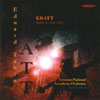Tubin Kratt
The first outing on disc for Tubin’s colourful, folk-inspired dance-drama
View record and artist detailsRecord and Artist Details
Composer or Director: Eduard Tubin
Genre:
Orchestral
Label: Alba
Magazine Review Date: 1/2006
Media Format: CD or Download
Media Runtime: 113
Mastering:
Stereo
DDD
Catalogue Number: ABCD195

Tracks:
| Composition | Artist Credit |
|---|---|
| Sinfonietta on Estonian motifs |
Eduard Tubin, Composer
Arvo Volmer, Conductor Eduard Tubin, Composer Estonian National Symphony Orchestra |
| Kratt |
Eduard Tubin, Composer
Arvo Volmer, Conductor Eduard Tubin, Composer Estonian National Symphony Orchestra |
Author: Guy Rickards
One ‘of the most shining pearls of the whole of 20th-century music’ is how Vardo Rumessen values Kratt (‘Goblin’), Eduard Tubin’s – and, reputedly, Estonia’s – first ballet score. What appears on this double album needs some explanation, however, because the version given is not that completed in January 1940 for a competition, nor the revision eventually premiered in 1943, but rather a reconstruction made by the exiled Tubin in Sweden in 1960. (Rumessen charts the score’s eventful life in a detailed essay in the booklet.)
Kratt’s plot, devised by Elfriede Saarik (whom Tubin married in 1941), is a fusion of elements from Estonian folk-tales. To enrich himself, a greedy farmer is advised by a wizard to manufacture a treasure-finding goblin, Kratt. To do so, the farmer barters his soul with the Devil, armed to prevent any double-cross thanks to the Wizard. At home, the farmer is trying to keep his daughter apart from an amorous farmhand, who by chance discovers that the farmer has fallen in with a devil-worshipping cult. A misunderstanding brings Kratt and the farmhand into conflict but the worsted goblin’s wrath is vented on the farmer, finally burning down his house and strangling his creator.
Tubin matched this scenario with a folk-rich musical accompaniment of great verve, though there are undeniable longueurs (some productions replace the long second act with Tubin’s briefer Solo Violin Sonata.) Volmer and the Estonian orchestra give a characterful and committed performance, playing on the score’s strengths, though there’s no denying the composer extracted the finest music for his 1961 Suite (9/86). There is plenty to enjoy, too, in the Sinfonietta on Estonian Motifs (1940), even if Järvi’s Gothenburg account is better, and one excuses the slightly derivative nature of the score (witness the finale’s echoes of Petrushka). Fine sound makes this an issue well worth investigating.
Kratt’s plot, devised by Elfriede Saarik (whom Tubin married in 1941), is a fusion of elements from Estonian folk-tales. To enrich himself, a greedy farmer is advised by a wizard to manufacture a treasure-finding goblin, Kratt. To do so, the farmer barters his soul with the Devil, armed to prevent any double-cross thanks to the Wizard. At home, the farmer is trying to keep his daughter apart from an amorous farmhand, who by chance discovers that the farmer has fallen in with a devil-worshipping cult. A misunderstanding brings Kratt and the farmhand into conflict but the worsted goblin’s wrath is vented on the farmer, finally burning down his house and strangling his creator.
Tubin matched this scenario with a folk-rich musical accompaniment of great verve, though there are undeniable longueurs (some productions replace the long second act with Tubin’s briefer Solo Violin Sonata.) Volmer and the Estonian orchestra give a characterful and committed performance, playing on the score’s strengths, though there’s no denying the composer extracted the finest music for his 1961 Suite (9/86). There is plenty to enjoy, too, in the Sinfonietta on Estonian Motifs (1940), even if Järvi’s Gothenburg account is better, and one excuses the slightly derivative nature of the score (witness the finale’s echoes of Petrushka). Fine sound makes this an issue well worth investigating.
Discover the world's largest classical music catalogue with Presto Music.

Gramophone Digital Club
- Digital Edition
- Digital Archive
- Reviews Database
- Full website access
From £8.75 / month
Subscribe
Gramophone Full Club
- Print Edition
- Digital Edition
- Digital Archive
- Reviews Database
- Full website access
From £11.00 / month
Subscribe
If you are a library, university or other organisation that would be interested in an institutional subscription to Gramophone please click here for further information.




